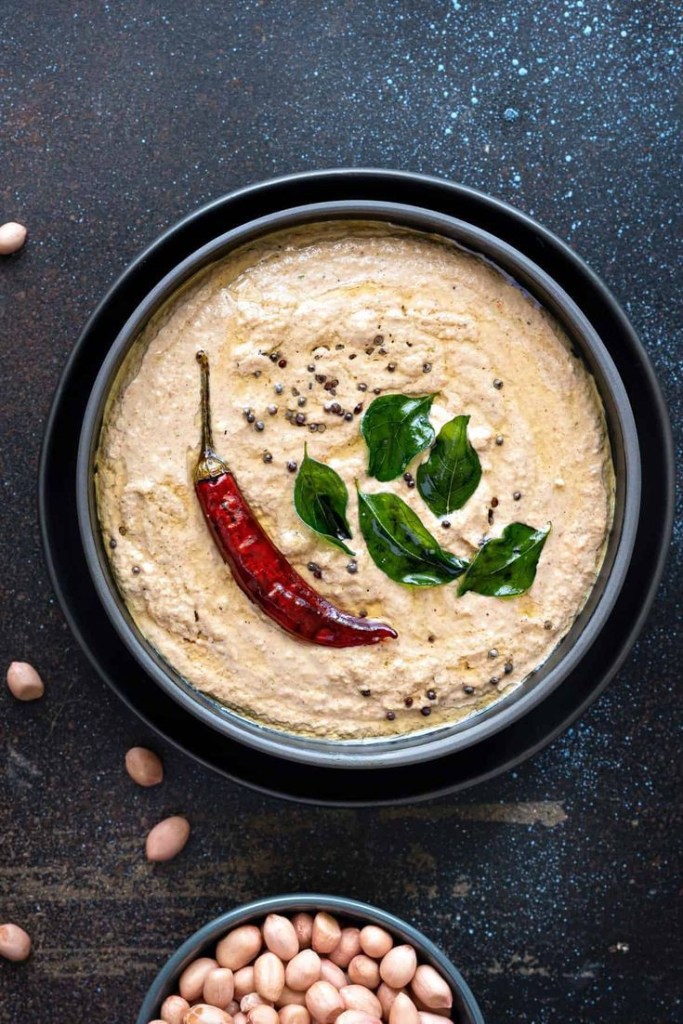Peanut Chutney
Peanut chutney is a versatile South Indian condiment known for its nutty, spicy, and tangy flavors. It can be customized with variations like coconut or tomato, offering a creamy texture and delightful taste. Peanut chutney provides nutritional benefits and can be enjoyed with a variety of dishes.
Origin
Peanut chutney is a popular condiment in South Indian cuisine, particularly in Andhra Pradesh, Tamil Nadu, and Karnataka. It is believed to have originated in these regions, where peanuts are widely grown and form an essential part of the local culinary traditions.
Characteristics
- Flavor Profile: Peanut chutney offers a unique combination of nuttiness, spiciness, tanginess, and a hint of sweetness. It has a rich, creamy texture with a balanced blend of flavors.
- Versatility: This chutney can be customized to suit individual preferences, ranging from mild to spicy, and can be adjusted to complement various dishes.
- Nutritional Benefits: Peanut chutney is a good source of protein, healthy fats, fiber, vitamins, and minerals. It provides a nutritious addition to meals.
Variations of Peanut chutney
Peanut chutney can be prepared in several variations to add variety and enhance the flavors. Here are a few popular variations:
Coconut Peanut Chutney: This variation includes grated coconut, which adds a creamy texture and a touch of sweetness to the chutney.
Tomato Peanut Chutney: Adding tomatoes to the base ingredients lends a tangy and slightly sour taste, balancing the richness of the peanuts.
Spicy Peanut Chutney: By increasing the quantity of red chilies or adding other spicy ingredients, you can create a fiery version of peanut chutney.
Mint Peanut Chutney: Incorporating fresh mint leaves into the chutney adds a refreshing flavor and aroma, perfect for hot summer days.
Tips and Tricks for peanut chutney
- Roasting Peanuts: Roasting the peanuts before making the chutney enhances their flavor. Remove the skins for a smoother texture.
- Balance the Flavors: Adjust the amount of spice, tanginess (from tamarind or lemon juice), and sweetness (from jaggery or sugar) to achieve the desired taste.
- Consistency: Gradually add water while blending to achieve the desired thickness and consistency of the chutney.
- Tempering: Enhance the flavor by adding a tempering of mustard seeds, curry leaves, and dried red chilies to the chutney.
Health Benefits
- Protein Source: Peanuts are a good plant-based source of protein, essential for muscle repair and growth.
- Heart-Healthy Fats: Peanuts are rich in monounsaturated fats, which can help lower bad cholesterol levels and reduce the risk of heart disease.
- Fiber-Rich: Peanut chutney contains dietary fiber that aids in digestion, promotes satiety, and helps regulate blood sugar levels.
- Nutrient Content: Peanuts are a good source of vitamins, minerals, and antioxidants, including vitamin E, folate, magnesium, and resveratrol, which contribute to overall health and well-being.
Other Chutney recipes


Restaurant style Peanut Chutney
Peanut chutney is a versatile South Indian condiment known for its nutty, spicy, and tangy flavors. It can be customized with variations like coconut or tomato, offering a creamy texture and delightful taste. Peanut chutney provides nutritional benefits and can be enjoyed with a variety of dishes.
Ingredients
For tempering
Instructions
-
Peanut chutney
In a pan or kadai, add the raw peanuts and roast them nicely till golden brown.
Cool them and remove the skin and keep aside.
In a mixer jar or blender, add the roasted peanuts, grated coconut, red chilies, tamarind, salt and grind together to fine paste by adding little water.
Adjust the seasoning accordingly.
-
Tempering the peanut chutney
In a pan add oil, once heated add mustard seeds, dry red chilies, curry leaves and just toss till curry leaves cracks and pour over the chutney.
If you want more quantity, add the chutney in the pan and add water and adjust seasoning and just cook for an 30 sec to 1 minutes.
Do not overcook the chutney as it loses the flavor.
Servings 4
- Amount Per Serving
- Calories 166kcal
- % Daily Value *
- Total Fat 14.4g23%
- Saturated Fat 3.6g18%
- Sodium 491mg21%
- Potassium 207mg6%
- Total Carbohydrate 5.6g2%
- Dietary Fiber 2.8g12%
- Sugars 1.9g
- Protein 6.7g14%
- Calcium 24 mg
- Iron 2 mg
* Percent Daily Values are based on a 2,000 calorie diet. Your daily value may be higher or lower depending on your calorie needs.








